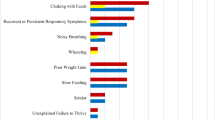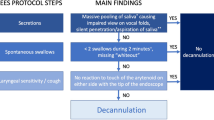Abstract
The objective of this study is to investigate in infants submitted to videofluoroscopic swallowing study (VFSS) during the first year of life, the association between aspiration and later tube feeding, and to identify potential risk factors related to feeding route outcome. Retrospective cohort study with data from electronic health records was performed. Data were collected from infants < 12 months of age who underwent VFSS during inpatient hospital stay in the period between 2013 and 2018. Patient charts after 24 months of age were reviewed to ascertain the outcome and study factors, including VFSS findings, neonatal data, clinical comorbidities, nutritional status, ICU admissions, and hospital readmissions. Relative risk (RR) for tube feeding was calculated, and a Poisson regression with robust variance was used to identify potential risk factors. VFSS data from 164 patients < 1 year old were retrieved, of whom 112 (68%) contributed with data about feeding route after 2 years of age. Most infants were preterm < 37 weeks (66%), with a median age of 9.28 weeks at the time of the exam. Aspiration occurred in 33% of the patients, with no statistically significant difference between full-term or premature infants (p = 0.173). The relative risk of tube feeding after the age of 2 among infants who aspirated in VFSS was 0.74 (CI 0.25–2.16, p = 0.573). Poisson regression analysis showed that number of hospital readmissions (RR 1.04, 95%CI 1.01–1.07, p = 0.005) and gestational age < 34 weeks (RR 0.26, 95%CI 0.07–0.089, p = 0.032) were associated with later tube feeding. Early VFSS findings have low predictive value regarding later feeding route. Aspiration events should be considered as complementary information for clinical decision.


Similar content being viewed by others
References
Lawlor CM, Choi S. Diagnosis and management of pediatric dysphagia: a review. JAMA Otolaryngology-Head & Neck Surgery. 2020;146:183–91.
Hoffmeister J, Zaborek N, Thibeault SL. Postextubation dysphagia in pediatric populations: incidence, risk factors, and outcomes. J Pediatr. 2019;211:126–33.
Kritzinger A, Da Costa MA, Graham MA, et al. Prevalence and associated prenatal and perinatal risk factors for oropharyngeal dysphagia in high-risk neonates in a South African hospital. South African Journal of Communication Disorders. 2019;66:1–8.
Gasparin M, Schweiger C, Manica D, et al. Accuracy of clinical swallowing evaluation for diagnosis of dysphagia in children with laryngomalacia or glossoptosis. Pediatr Pulmonol. 2016;52:41–7.
Frakking TT, Chang AB, O’Grady KAF, et al. The use of cervical auscultation to predict oropharyngeal aspiration in children: a randomized controlled trial. Dysphagia. 2016;31:738–48.
Malkar MB, Jadcherla S. Neuromotor mechanisms of pharyngoesophageal motility in dysphagic infants with congenital heart disease. Pediatr Res. 2014;76:190–6.
Slaughter JL. Neonatal aerodigestive disorders: epidemiology and economic burden. Clin Perinatol. 2020;47:211–22.
Velayutham P, Irace AL, Kawai K, et al. Silent aspiration: Who is at risk? Laryngoscope. 2017;128:1952–7.
Weir KA, McMahon S, Taylor S, et al. Oropharyngeal aspiration and silent aspiration in children. Chest. 2011;140:589–97.
Hernandez AM, Bianchini EMG. Swallowing analyses of neonates and infants in breastfeeding and bottle-feeding: impact on videofluoroscopy swallow studies. International archives of otorhinolaryngology. 2019;23:343–53.
Duncan DR, Larson K, Davidson K, et al. Feeding interventions are associated with improved outcomes in children with laryngeal penetration. J Pediatr Gastroenterol Nutr. 2019;68:218.
Lore G, Vernuccio F, Di Vittorio ML, et al. Swallowing evaluation with videofluoroscopy in the paediatric population. Acta Otorhinolaryngol Ital. 2019;39:188–279.
Gulati IK. Approach to feeding difficulties in neonates and infants. Clin Perinatol. 2020;47:265–76.
McGrattan KE, McGhee HC, McKelvey KL, et al. Capturing infant swallow impairment on videofluoroscopy: timing matters. Pediatr Radiol. 2020;50:199–206.
Tutor JD, Gosa MM. Dysphagia and aspiration in children. Pediatr Pulmonol. 2011;47:321–37.
Martin-Harris B, Brodsky MB, Michel Y, et al. MBS measurement tool for swallow impairment—MBSImp: establishing a standard. Dysphagia. 2008;23:392–405.
Dharmarathna I, Miles A, Allen J. Twenty years of quantitative instrumental measures of swallowing in children: a systematic review. Eur J Pediatr. 2020;179:203–23.
Arvedson JC, Lefton-Greif MA. Instrumental assessment of pediatric dysphagia. In Seminars in speech and language. 2017;38:135–46.
Lefton-Greif MA, McGrattan KE, Carson KA, et al. First steps towards development of an instrument for the reproducible quantification of oropharyngeal swallow physiology in bottle-fed children. Dysphagia. 2017;33:76–82.
Martin-Harris B, Canon CL, Bonilha HS, et al. Best practices in modified Barium swallow studies. Am J Speech Lang Pathol. 2020;29:1078–93.
Edwards S, Davis AM, Bruce A, et al. Caring for tube-fed children. J Parenter Enter Nutr. 2015;40:616–22.
Casazza GC, Graham ME, Asfour F, et al. Aspiration in the otherwise healthy Infant—Is there a natural course for improvement? Laryngoscope. 2019;130:514–20.
Shay EO, Meleca JB, Anne S, et al. Natural history of silent aspiration on modified barium swallow studies in the pediatric population. Int J Pediatr Otorhinolaryngol. 2019;125:116–21.
Rosenbek JC, Robbins JA, Roecker EB, et al. A penetration-aspiration scale. Dysphagia. 1996;11:93–8.
Hintze JL (2008) Quick Start Manual. PASS Power Analysis and Sample Size System. https://www.ncss.com/wp-content/uploads/2012/09/PASS11QuickStart.pdf. Accessed 13 April 2021.
Bujang MA, Adnan TH. Requirements for minimum sample size for sensitivity and specificity analysis. J Clin Diagn Res. 2016;10:1–6.
Balest AL, White KE, Shaffer AD, et al. Consideration of cough reflex development when ordering modified barium swallow studies in infants. Dysphagia. 2020;35:533–41.
Narawane A, Eng J, Rappazzo C, et al. Airway protection & patterns of dysphagia in infants with down syndrome: Videofluoroscopic swallow study findings & correlations. Int J Pediat Otorhinolaryngol. 2020;132:1099.
Stanley MA, Shepherd N, Duvall N, et al. Clinical identification of feeding and swallowing disorders in 0–6 month old infants with Down syndrome. Am J Med Genet A. 2018;179:177–82.
Simons JP, Greenberg LL, Mehta DK, et al. Laryngomalacia and swallowing function in children. Laryngoscope. 2015;126:478–84.
McSweeney ME, Meleedy-Rey P, Kerr J, et al. A quality improvement initiative to reduce gastrostomy tube placement in aspirating patients. Pediatrics. 2020;145:1–10.
Acknowledgements
We would like to thank the Universidade Federal do Rio Grande de Sul (UFRGS) and CAPES Foundation (Brazil) for granting a scholarship for the present study.
Author information
Authors and Affiliations
Corresponding author
Ethics declarations
Conflict of interest
All authors declare that they have no conflict of interest to report.
Ethical approval
The study was approved by the Institutional Review Board of the Hospital de Clínicas de Porto Alegre. A confidentiality term was signed by all researchers.
Additional information
Publisher's Note
Springer Nature remains neutral with regard to jurisdictional claims in published maps and institutional affiliations.
Rights and permissions
About this article
Cite this article
Miranda, P.P., Levy, D.S. & Kieling, R.R. Aspiration in the First Year of Life and Later Tube Feeding: A Retrospective Cohort from a Low-Income Country. Dysphagia 38, 192–199 (2023). https://doi.org/10.1007/s00455-022-10450-4
Received:
Accepted:
Published:
Issue Date:
DOI: https://doi.org/10.1007/s00455-022-10450-4




